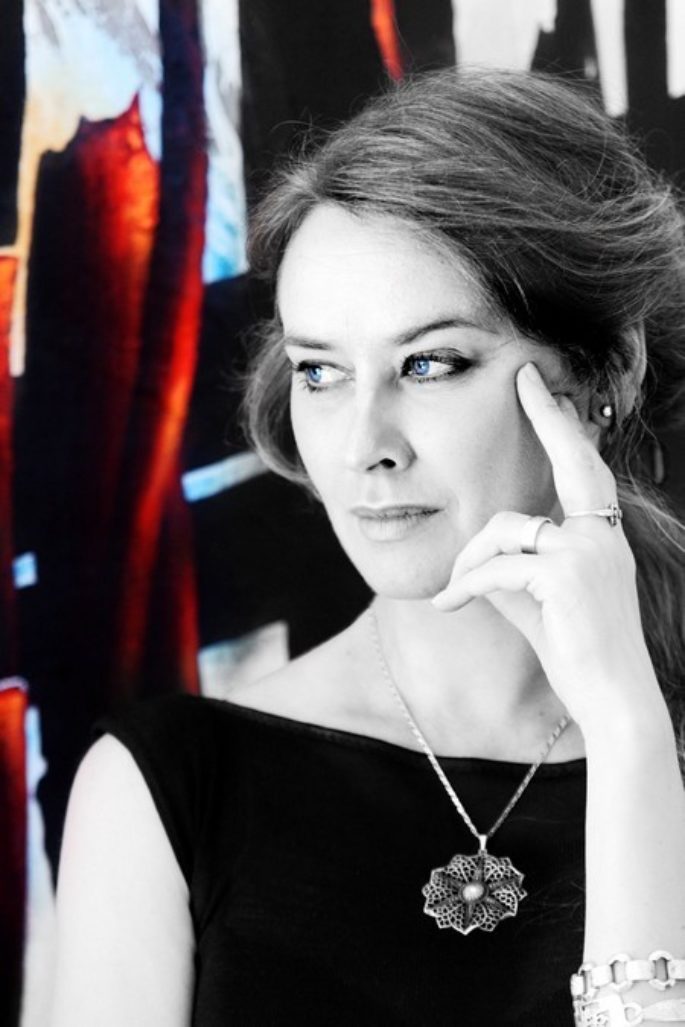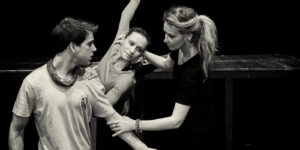Text: Ludmila PetříkováPhoto: archive of the F. X. F.X. Šalda Theatre
The dancer and choreographer Alena Pešková could be admired by ballet lovers for example in the role of Pamina from The Magic
fl étny, or as the cruel Lady Macbeth or the romantic and tender Marguerite in the ballet The Lady with the Camellias. This role
in 2003, which earned her a wider nomination for the Thalia Award. Since September last year, she has fulfilled the mission of choreographer and ballet director
F. X. Šalda Theatre in Liberec.
How old were you when you started ballet?
I started ballet very late. Approximately ten years later than my classmates from the conservatory, who mostly started at the age of four, in the National Theatre's preparatory school. At the age of thirteen, I saw the famous Flashdance and it was clear to me that I would be a welder first and then a ballerina /I eventually gave up welding/. But when you say you want to be a ballet dancer in a working-class town in the east of Bohemia during the communist era, it sounds even more stupid than if you say you're going to be an astronaut. Fortunately, my parents didn't quite fit into the color scheme of the time and place, so they agreed.And maybe just to get rid of my hysteria, they took me to Prague to the dance conservatory, to let the experts judge that it was too late for ballet...or...that I should try again next year. They already kept me.
You have portrayed many characters during your dancing career. Which of them was most in keeping with your character?
Actually, I don't know what my naturel is. I guess that's for others to judge.I enjoyed the tender and romantic Lady with Camellias on stage, as well as the brutal embodiment of evil, Lady Macbeth.I also liked the comic Pamina. And now I'm enjoying the "brooding" Morgiana. And who am I? Much has been written about the theatre from a metaphysical point of view, so maybe I'll find myself soon, or end up in a psychiatric ward...
Apart from dancing, you are a choreographer, director and scriptwriter. What led you to these professions?
I guess the desire to express oneself without words. Nonverbal communication is what attracts me. Everyone has told me since I was a kid that if I want to, you can see what I'm thinking without speaking.Notice the slight tilt of my head, one eyebrow up, one elbow tucked, one foot striding, and you know you're going to get punched in the mouth. And anyway, there's a lot of talk these days, nobody listens, the word devalues. I also use it in my productions, but more as a symbol. We should only speak in poems, to be aware of form and content. Gestures are more eloquent today. Politicians know this and use and abuse it. Go see a good dance theatre, you will see how the dancers are communicative without words.
What is the interest in ballet and dance performances in today's consumerist and hectic times?
I'm gonna go a little overboard here. There are currently three Swan Lakes running in Prague, on three different stages, in three different productions, and all of them are making a living. I won't mention their quality. Swan Lake is simply the biggest "commercial" in ballet. You put Swan Lake on and you can't lose. Everyone wants to see it, and then applauds and applauds without evaluating, without comparing, without having a "clue". Then you have the other extreme, the so-called "independents" who depend on smaller or larger grants.I would estimate about 200 of them in Prague. They attend each other's shows. Well, and if you add friends and parents... hula hoop! You have a full auditorium - a success!.Of course, you rarely see a "civilian" there, which I sometimes regret, because there are also quality performances. But more often - as I like to say - people throw themselves on the floor for three hours, pretending some abstract emotion. They address feminism, pessimism, Marxism and Leninism. You can just put it on anything. I don't understand it myself. I recognize it in my own body like this. I go to Japan every year with a concert program. I walk on stage with a brilliant crown on my head, satin toes on my feet, and suddenly 3,000 Japanese people are applauding me, and I'd do anything! At that moment, I'm thinking, "Oh, my God! I'd rather play in a moldy basement for five "insiders". A month later, I have a performance of Jessie and Morgiana at the Malostranskábeseda and I pray that at least a few "street" spectators will come. What does that mean? That only snobs go to the ballet, or a closed cult society around dance? For God's sake, no! There are exceptions, but why are they exceptions, whose fault is it? First of all, we "ballet people" make it either a museum or a "terribly intellectual and philosophical" affair. Secondly, the spectator, for not choosing, not looking, not comparing, not whistling and shouting "bravo". He swallows it and next time he won't come.I think the solution is in the "narrative". An intelligible narrative, but not in a banal, trivial and semi-popular form. It doesn't have to be a story, it can be a narration of thoughts, emotions...but to give the viewer the feeling that he understands something and still leave room for questions, for his imagination. And that's what you can do so well without words. And sometimes it's a great power - the combination of music, gesture. There are such performances. You just have to find them. Ballet is not dead. I repeat, you can say almost anything. It's just harder to lie without words.
From the new theatre season you are the head and choreographer of the ballet of the F. X. Šalda Ballet in Liberec. How do you feel in this position and what are you preparing with the company?
Sometimes I get a little annoyed with the organizing, but that's redeemed.I can do my own dramaturgy. And then there's the longer-term work with one ensemble, with specific people. As I said somewhere, good technique is supposed to be a given, but style is the superstructure, which is what it's all about, at least for me, as a creator and as a spectator. And the choreographer just needs a longer period of time to transfer what he needs from his style to the ensemble.Maybe I see it too rosy, but I feel that it's starting to work, that we are hearing each other, that we are getting to know each other, that we are opening up to things we haven't done before. I want to see personalities on stage, and they're becoming them. Sometimes it moves me. Of course, it's not just "my style" that I'm pushing hard in Periphery. There's also Charlotte, a beautiful neo-classical by Jiri Horák, where the style is somewhere else. Different stage posture, body position, different acting. You have to differentiate.I want the repertoire to remain balanced.




Comments are closed.